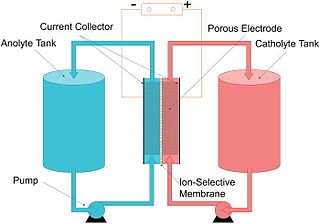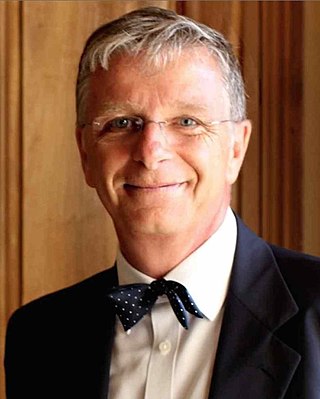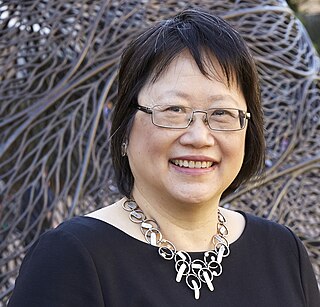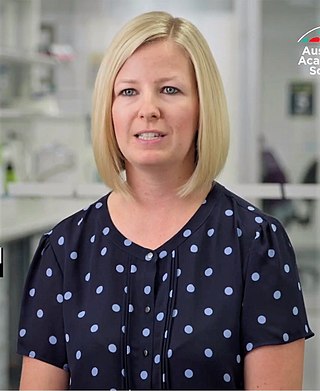Related Research Articles

The vanadium redox battery (VRB), also known as the vanadium flow battery (VFB) or vanadium redox flow battery (VRFB), is a type of rechargeable flow battery. It employs vanadium ions as charge carriers. The battery uses vanadium's ability to exist in a solution in four different oxidation states to make a battery with a single electroactive element instead of two. For several reasons, including their relative bulkiness, vanadium batteries are typically used for grid energy storage, i.e., attached to power plants/electrical grids.

A flow battery, or redox flow battery, is a type of electrochemical cell where chemical energy is provided by two chemical components dissolved in liquids that are pumped through the system on separate sides of a membrane. Ion transfer inside the cell occurs through the membrane while both liquids circulate in their own respective space. Cell voltage is chemically determined by the Nernst equation and ranges, in practical applications, from 1.0 to 2.43 volts. The energy capacity is a function of the electrolyte volume and the power is a function of the surface area of the electrodes.

Michael Stanley Whittingham is a British-American chemist. He is currently a professor of chemistry and director of both the Institute for Materials Research and the Materials Science and Engineering program at Binghamton University, State University of New York. He also serves as director of the Northeastern Center for Chemical Energy Storage (NECCES) of the U.S. Department of Energy at Binghamton. He was awarded the Nobel Prize in Chemistry in 2019 alongside Akira Yoshino and John B. Goodenough.
The polysulfide-bromine battery, is a type of rechargeable electric battery, which stores electric energy in liquids, such as water-based solutions of two salts: sodium bromide and sodium polysulfide. It is an example and type of redox (reduction–oxidation) flow battery.
Esther Sans Takeuchi is a materials scientist and chemical engineer, working on energy storage systems and power sources for biomedical devices. She is also a Distinguished Professor at Stony Brook University and a chief scientist at Brookhaven National Laboratory. She holds more than 150 U.S. patents. “The battery was invented once and reinvented over 100 times. I don’t own the patent. The company does. It was called Greatbatch. Now it’s called Integer Corp. When you join a company, you sign over your patent rights to the company.”

Adam Heller is an Israeli American scientist and engineer. He is Chief Science Officer of SynAgile Corp. of Wilson, Wyoming, consults to Abbott Diabetes Care of Alameda, California, and is Ernest Cockrell Sr. Chair Emeritus of Engineering at The University of Texas at Austin. His 1973 paper with James J. Auborn established the feasibility of high energy density, high-voltage, non-rechargeable lithium batteries. Their 3.6-volt lithium thionyl chloride and 3.7-volt lithium sulfuryl chloride batteries remain in use in applications requiring very high energy density and a shelf life of 20 years or more.

Katharina Gaus was a German-Australian immunologist and molecular microscopist. She was an NHMRC Senior Research Fellow and founding head of the Cellular Membrane Biology Lab, part of the Centre for Vascular Research at the University of New South Wales. Gaus used new super-resolution fluorescence microscopes to examine the plasma membrane within intact living cells, and study cell signalling at the level of single molecules to better understand how cells "make decisions". A key discovery of Gaus and her team was how T-cells decide to switch on the body's immune system to attack diseases. Her work is of importance to the development of drugs that can work with T-cells in support of the immune system.
Martina Heide Stenzel is a Professor in the Department of Chemistry at the University of New South Wales (UNSW). She is also a Royal Australian Chemical Institute (RACI) University Ambassador. She became editor for the Australian Journal of Chemistry in 2008 and has served as Scientific Editor and as of 2021, as Editorial Board Chair of RSC Materials Horizons.

Frances Separovic is a biophysical chemist, Distinguished Professor Emeritus of Chemistry, Deputy Director of the Bio21 Institute and former Head of the School of Chemistry at the University of Melbourne, where she taught physical chemistry and graduate students in her field. She is credited with developing a technique which utilises nuclear magnetic resonance spectroscopy (NMR) to study peptides in aligned lipid bilayers, and has applications in the study of the structure of membrane proteins and their effects on the membrane. Her current research concerns 'the structure and interactions of amyloid peptides from Alzheimer's disease, pore-forming toxins and antibiotic peptides in model biological membranes'.
Jeanne Beadle Burbank worked for 25 years at the United States Naval Research Laboratory (NRL), studying the materials and components of lead-acid and silver-zinc batteries used in submarines. She was acknowledged internationally as an expert in the field of electrochemistry.

Hubert Girault (born 13 February 1957 in Saint-Maur-des-Fossés, France) is a Swiss chemist and is Emeritus Professor at the École Polytechnique Fédérale de Lausanne (1992-2022). He was the director of the Laboratoire d'Electrochimie Physique et Analytique, with expertise in electrochemistry at soft interfaces, Lab-on-a-Chip techniques, bio-analytical chemistry and mass-spectrometry, artificial water splitting, CO2 reduction, and redox flow batteries.
The Castner Gold Medal on Industrial Electrochemistry is an biennial award given by the Electrochemical Technology Group of Society of Chemical Industry (SCI) to an authority on applied electrochemistry or electrochemical engineering connected to industrial research. The award is named in honor of Hamilton Castner, a pioneer in the field of industrial electrochemistry, who patented in 1892 the mercury cell for the chloralkali process. Castner was an early member of SCI.
Susan Nan Coppersmith is an American condensed matter physicist. Formerly the Robert E. Fassnacht Professor of Physics and Vilas Research Professor in the Department of Physics at the University of Wisconsin–Madison, she moved in 2018 to the University of New South Wales.
Linda Faye Nazar is a Senior Canada Research Chair in Solid State Materials and Distinguished Research Professor of Chemistry at the University of Waterloo. She develops materials for electrochemical energy storage and conversion. Nazar demonstrated that interwoven composites could be used to improve the energy density of lithium–sulphur batteries. She was awarded the 2019 Chemical Institute of Canada Medal.
Shelley D. Minteer is an American academic and chemistry professor at the University of Utah. Minteer field of study focuses on the interface between biocatalysts and enzyme-based electrodes for biofuel cells and sensors.
Viola Ingrid Birss is a Professor of Chemistry at the University of Calgary. She works on electrochemistry and the development of nanomaterials for sustainable energy and sensing applications. She has demonstrated a metal oxide perovskite that can be used as the air and fuel electrode in solid oxide fuel cells, as well as creating nanoporous carbon scaffolds to be used in batteries and capacitors.

Prof. Vicki Chen is an Australian engineer, and the Executive Dean for the Faculty of Engineering, Architecture and Information Technology at the University of Queensland. In 2020 she was elected as the Fellow of Australian Academy of Technology and Engineering.

Debbie Silvester is a British-Australian chemist who is a professor at Curtin University. Her research considers electrochemical processes and sensing. She has explored room-temperature ionic liquids. In 2021, she was awarded the Australian Academy of Science Le Fèvre Medal.
The Iron Redox Flow Battery (IRFB), also known as Iron Salt Battery (ISB), stores and releases energy through the electrochemical reaction of iron salt. This type of battery belongs to the class of redox-flow batteries (RFB), which are alternative solutions to Lithium-Ion Batteries (LIB) for stationary applications. The IRFB can achieve up to 70% round trip energy efficiency. In comparison, other long duration storage technologies such as pumped hydro energy storage provide slightly higher efficiencies.
Elod L. Gyenge is a professor of Chemical and Biological Engineering at the faculty of Applied Science in University of British Columbia in Vancouver, BC, Canada. He is also an associate member of the Clean Energy Research Center of UBC Vancouver campus. Elod Gyenge has been nominated for several teaching and research awards including Japanese Society for Promotion of Science (JSPS) Fellowship at Osaka University and the recipient of the distignshuied Elisabeth and Leslie Gould Endowed Professorship at UBC from 2007 to 2014. His research has been toward development of electrochemical systems such as fuel cells, batteries and electrosynthesis systems. He is also an appointed professor in the engineering school of Osaka University in Japan.
References
- ↑ M. Rychcik and M. Skyllas-Kazacos, J. Power Sources, 22 (1988) 59–67
- ↑ "Discovery and invention: How the vanadium flow battery story began". Energy Storage News. 18 October 2021. Archived from the original on 18 October 2021.
- 1 2 SKYLLAS-KAZACOS, Maria - Member of the Order of Australia (AM), 26 January 1999, It's an Honour
- ↑ "Emeritus Professor Maria Skyllas-Kazacos". research.unsw.edu.au. UNSW Research. Retrieved 28 March 2018.
- 1 2 3 4 5 6 Hooker, Claire (2000). "Professor Maria Skyllas-Kazacos, chemical engineer". Interviews with Australian Scientists. Australian Academy of Science. Retrieved 7 April 2018.
- ↑ "Skyllas-Kazacos, Maria (1951-)". People and organisations. trove.nla.gov.au. Retrieved 27 March 2018.
- 1 2 3 4 5 Keashly, Laurelle. "Maria Skyllas Kazacos, inventor of VRB technology in profile". www.vanadiumcorp.com. VanadiumCorp Resource Inc. Retrieved 7 April 2018.
- ↑ Walker, Rosanne (5 February 2010). "Skyllas-Kazakos, Maria". Biographical entry. Encyclopedia of Australian Science. Retrieved 28 March 2018.
- ↑ Skyllas-Kazacos, Maria (June 1983). "Electrodeposition of CdSe and CdSe+CdTe thin films from cyanide solutions". Journal of Electroanalytical Chemistry and Interfacial Electrochemistry. 148 (2): 233–239. doi:10.1016/S0022-0728(83)80399-4.
- ↑ Prifti, Helen; Parasuraman, Aishwarya; Winardi, Suminto; Lim, Tuti Mariana; Skyllas-Kazacos, Maria (19 June 2012). "Membranes for Redox Flow Battery Applications". Membranes. 2 (2): 275–306. doi: 10.3390/membranes2020275 . PMC 4021890 . PMID 24958177.
- ↑ "Emeritus Professor Maria Skyllas-Kazacos". Engineering. University of New South Wales. 10 February 2015. Retrieved 28 March 2018.